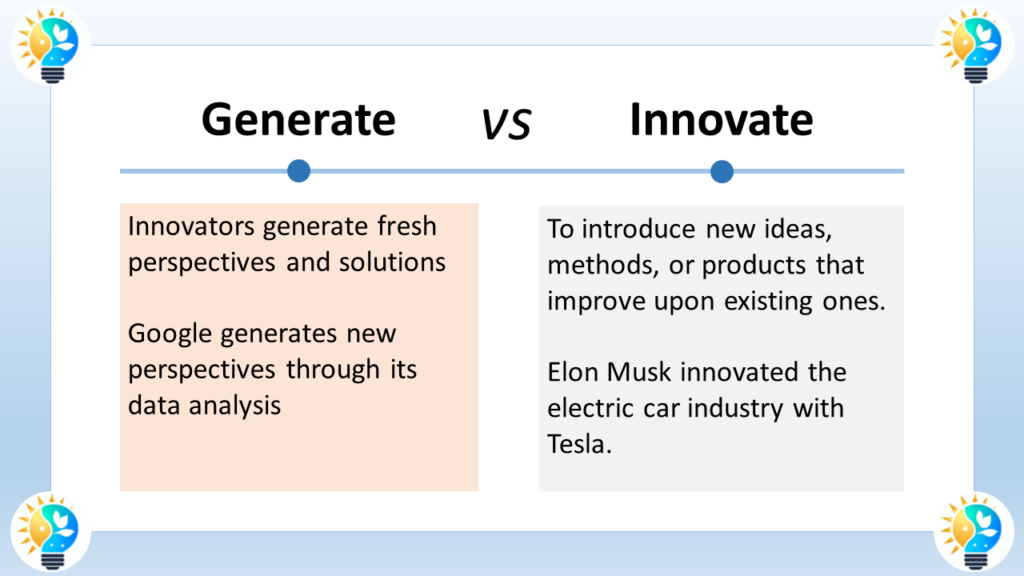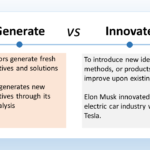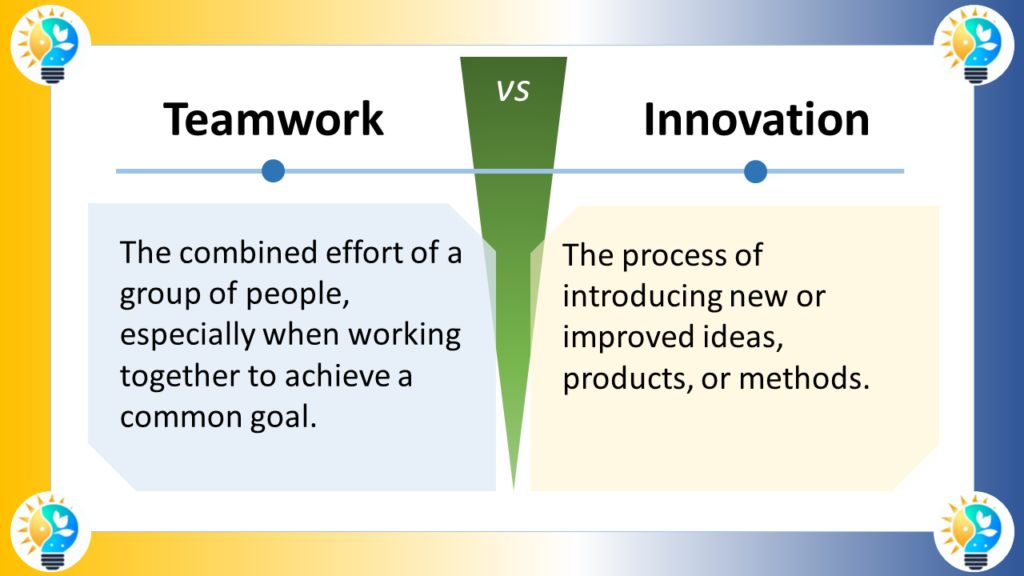Generating involves producing or creating something new, while innovating involves improving upon existing ideas.
Generating is often a more passive process, while innovating involves active effort.

Generate and Innovate: The Dynamic Duo of Progress
The terms generate and innovate are often used interchangeably, but they have distinct meanings that contribute to the process of creating new ideas, products, and services. This article explores the relationship between generate and innovate, highlighting their differences and similarities, and how they work together to drive progress.
Definitions
innovate refers to making changes or doing something in a new way. It involves the generation, admission, and realization of new ideas, products, services, and processes. Innovation is about the practical implementation of new or improved abilities to make a meaningful impact in a market or society. It can take many forms, from incremental improvements to existing products or processes to disruptive new inventions.
generate can be used to describe the act of producing or creating something. It does not necessarily imply the introduction of a new idea or method. Unlike innovation, which is about the practical implementation of new ideas, generation is more general and can refer to the act of producing something without the connotation of novelty or improvement.
More Synonyms on innovation, innovate and innovative:
- Adapt
- Advance
- Change
- Create
- Cultivate
- Devise
- Develop
- Discover
- Disrupt
- Evolve
- Experiment
- Fashion
- Generate
- Imagine
- Initiate
- Introduce
- Invent
- Modernize
- Originate
- Pioneer
- Progress
- Prototype
- Radicalize
- Reform
- Reinvent
- Renew
- Revolutionize
- Restructure
- Set Trends
- Transform
- Upgrade

Innovation is considered as a driving force in progress.
It includes the introduction of novel ideas, methods, or products that bring positive change and advancement.
For more information about innovations, check our glossary
Defining Generate
To generate is to produce or create something, often in large quantities or continuously. In the context of innovation, generating refers to the process of coming up with new ideas, concepts, or solutions. This can involve brainstorming sessions, research and development, market analysis, and other activities that help to identify opportunities and generate ideas.
According to the Harvard Business Review, “Generating ideas is the easy part of innovation. The hard part is converting those ideas into successful new products, services, or business models.” This highlights the importance of generating high-quality ideas that have the potential to create value and solve real-world problems.
Defining Innovate
To innovate is to introduce something new or make changes to existing products, services, or processes in order to improve them. Innovation involves taking risks, experimenting with new approaches, and continuously learning and adapting. It requires a mindset that embraces change, creativity, and collaboration.
As defined by the Business Dictionary, “Innovation is the process of translating an idea or invention into a good or service that creates value or for which customers will pay.” This definition emphasizes the importance of creating value through innovation and the role of the customer in driving innovation.
The Relationship between Generate and Innovate
While generate and innovate are distinct concepts, they are closely related and often occur in tandem. Generating ideas is an essential first step in the innovation process, as it provides the raw material for further development and refinement. However, simply generating ideas is not enough to drive innovation. Those ideas must then be evaluated, tested, and refined in order to create value and solve real-world problems.
Innovation involves taking the ideas generated through the ideation process and transforming them into something new and valuable. This can involve prototyping, testing, and iterating on those ideas until they are ready for market. Innovation also requires a willingness to take risks, embrace failure, and learn from mistakes.
Best Practices for Generating and Innovating
In order to effectively generate and innovate, organizations must create a culture that encourages creativity, collaboration, and experimentation. This can involve:
- Encouraging diverse perspectives and ideas
- Providing resources and support for innovation initiatives
- Creating cross-functional teams that bring together different areas of expertise
- Embracing failure as a learning opportunity
- Continuously seeking feedback from customers and stakeholders
Examples of Successful Innovation through Idea Generation
There are numerous examples of organizations that have successfully generated and innovated new products, services, and business models. One such example is the ride-sharing company Uber, which disrupted the traditional taxi industry by generating the idea of using smartphones to connect drivers with riders. Another example is the electric vehicle company Tesla, which has generated and innovated new battery technology that has helped to make electric cars more affordable and accessible to the masses.
Conclusion
The relationship between generate and innovate is a dynamic one that is essential for driving progress and creating value. By generating fresh perspectives and ideas, and then innovating on those ideas to create new products, services, and business models, organizations can stay ahead of the competition and create meaningful impact. By embracing a culture of creativity, collaboration, and experimentation, and by continuously seeking feedback from customers and stakeholders, organizations can unlock their full innovative potential.
Sources
- The History of Uber
- “Tesla’s Innovative Battery Technology.” Forbes
- Innovation – Wikipedia
- Innovation Definition – robllewellyn.com
- Innovate Definition – Merriam-Webster
- Innovation vs Invention – digitalleadership.com


